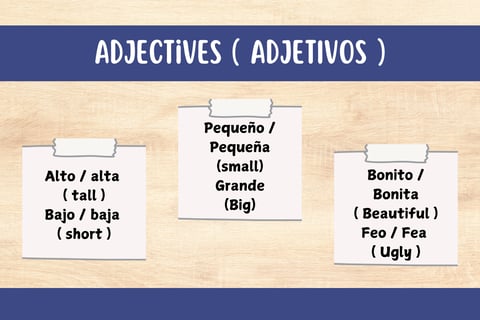START YOUR SPANISH LEARNING JOURNEY
Adjectives in Spanish - Los Adjetivos
Adjectives or los adjetivos describe nouns by telling you the size, shape, weight, color, nationality, or any other quality of the noun. You use them all the time! Adjectives add personality, creativity and detail to your sentences. They describe places, people and things around you.
ADJECTIVES - Los Adjetivos
Adjectives or los adjetivos describe nouns by telling you the size, shape, weight, color, nationality, or any other quality of the noun. You use them all the time! Adjectives add personality, creativity and detail to your sentences. They describe places, people and things around you.
Be careful while placing the adjectives. In Spanish, the adjectives comes after the noun they describe. Whereas in English, the adjectives come before the noun.
Adjectives serve the same purpose in Spanish or English, but they are very different in placements in a sentence.
Characteristics of Spanish Adjectives (Adjetivos)
1. Describe or modify a noun
2. Must change according to the gender and number of nouns
3. Usually placed after noun
4. sometimes modified by adverbs
Gender and Number of Spanish Adjectives
Spanish adjectives have 4 forms (Masculine singular & plural, Feminine singular & plural) i.e they change according to the gender and number of the nouns they are describing whereas in English adjectives just have one form.
1. masculine singular
2. masculine plural
3. feminine singular
4. feminine plural
If you’ve already studied the los sustantivos (nouns), you will find these rules familiar.
1) Regular adjectives
Masculine singular adjective usually ends in –o just like nouns and changes to -a for feminine singular. For plural adjectives, add –s same as nouns.
So most adjectives have these endings:
masculine singular-o and masculine plural -os
feminine singular -a and feminine plural -as
Por ejemplo…
negro (black)
masculine singular - negro
masculine plural - negros
feminine singular - negra
feminine plural - negras
2) Masculine adjective that end in -a or -e
The masculine and feminine forms are the same.
The plural adjective is still made by adding -s.
realista (realistic)
masculine singular - realista
masculine plural - realistas
feminine singular - realista
feminine plural - realistas
triste (sad)
masculine singular & feminine singular - triste
masculine plural & feminine plural - tristes
3) Masculine adjective ends in any consonant except -n, -r, or -z
The masculine and feminine forms are still the same as above.
Plural adjectives are changed by adding -es
dificil (difficult)
masculine singular & feminine singular - dificil
masculine plural & feminine plural - dificiles
4) Masculine adjective ends in -z
The masculine and feminine forms are still the same once again.
Plural adjectives are changed from -z to –c and adding -es.
feliz (happy)
masculine singular & feminine singular - feliz
masculine plural & feminine plural - felices
5) Masculine adjective ends in -n or -r*
Feminine singular is created by adding –a and plural by adding –as Whereas Masculine plural is created by adding –es
hablador (talkative)
masculine singular - hablador
masculine plural - habladores
feminine singular - habladora
feminine plural -habladoras


